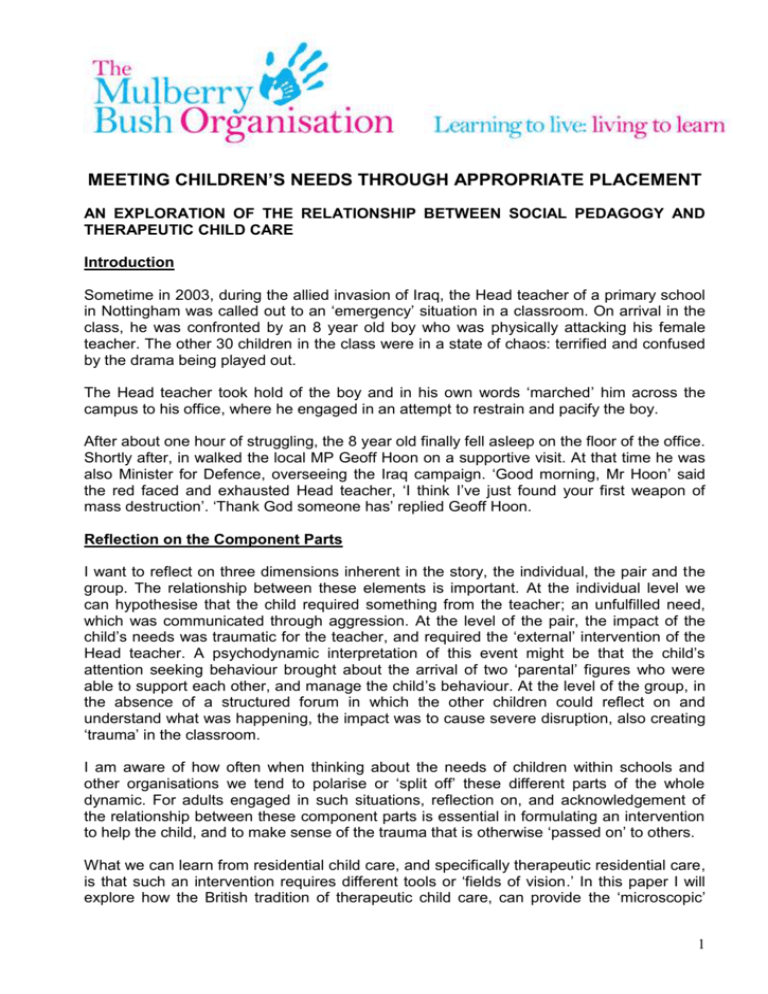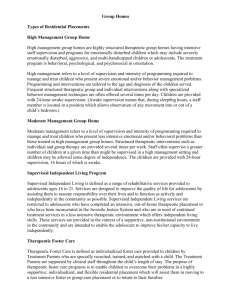Meeting Children`s Needs through appropriate Placement in
advertisement

MEETING CHILDREN’S NEEDS THROUGH APPROPRIATE PLACEMENT AN EXPLORATION OF THE RELATIONSHIP BETWEEN SOCIAL PEDAGOGY AND THERAPEUTIC CHILD CARE Introduction Sometime in 2003, during the allied invasion of Iraq, the Head teacher of a primary school in Nottingham was called out to an ‘emergency’ situation in a classroom. On arrival in the class, he was confronted by an 8 year old boy who was physically attacking his female teacher. The other 30 children in the class were in a state of chaos: terrified and confused by the drama being played out. The Head teacher took hold of the boy and in his own words ‘marched’ him across the campus to his office, where he engaged in an attempt to restrain and pacify the boy. After about one hour of struggling, the 8 year old finally fell asleep on the floor of the office. Shortly after, in walked the local MP Geoff Hoon on a supportive visit. At that time he was also Minister for Defence, overseeing the Iraq campaign. ‘Good morning, Mr Hoon’ said the red faced and exhausted Head teacher, ‘I think I’ve just found your first weapon of mass destruction’. ‘Thank God someone has’ replied Geoff Hoon. Reflection on the Component Parts I want to reflect on three dimensions inherent in the story, the individual, the pair and the group. The relationship between these elements is important. At the individual level we can hypothesise that the child required something from the teacher; an unfulfilled need, which was communicated through aggression. At the level of the pair, the impact of the child’s needs was traumatic for the teacher, and required the ‘external’ intervention of the Head teacher. A psychodynamic interpretation of this event might be that the child’s attention seeking behaviour brought about the arrival of two ‘parental’ figures who were able to support each other, and manage the child’s behaviour. At the level of the group, in the absence of a structured forum in which the other children could reflect on and understand what was happening, the impact was to cause severe disruption, also creating ‘trauma’ in the classroom. I am aware of how often when thinking about the needs of children within schools and other organisations we tend to polarise or ‘split off’ these different parts of the whole dynamic. For adults engaged in such situations, reflection on, and acknowledgement of the relationship between these component parts is essential in formulating an intervention to help the child, and to make sense of the trauma that is otherwise ‘passed on’ to others. What we can learn from residential child care, and specifically therapeutic residential care, is that such an intervention requires different tools or ‘fields of vision.’ In this paper I will explore how the British tradition of therapeutic child care, can provide the ‘microscopic’ 1 view of the individual and the therapeutic relationship, and how the ‘social’ can be viewed through the ‘binocular’ field of vision as defined by the current interest in ‘social pedagogy’ I believe that a singular focus on either the individual or the group is insufficient as a practice model in residential group care, but together they form a complementary three dimensional ‘field and ground’ framework for meeting the needs of emotionally troubled children. Meeting Need: The ‘Difficult and Damaged Child’ Relationships, the Group and Community The damaged child is one who produces challenging and difficult behaviours. We should not minimise the difficulty – as seen in the vignette above. Their behaviour can be demanding, exasperating, frightening and is almost invariably emotionally problematic. Among the most common challenging behaviours are: Inability to focus or concentrate, especially because the child is overwhelmed by powerful feelings. Being chaotic and disorganised – including an inability to stay still for any period of time, or to plan activity over time and generalised inability to control behaviour. Self harm. Aggression and violence towards others. At the same time we need to recognise that the difficult child is also a damaged child. The child’s experiences of the adults with whom they have lived so far and the institutions in which they have hitherto been educated – or lived - are such that we have to add to the list of challenging behaviours a list of problem dispositions. Most striking of these problem dispositions are: The inability to trust; especially trust adults A low capacity for attachment; again, especially to adults An inability to endure dependency An inability to endure uncertainty, even quite briefly. These problem dispositions are, of course, grounded in the experiences that have left the child a damaged and difficult child: abuse, both physical and sexual and neglect, and occasionally some physical impairment. Due to adverse experiences in early infancy and early childhood these children are left with high degrees of stress and bewilderment, a lack of trust in adults, and, of course, they display challenging chaotic, aggressive and sexualised behaviour. Because of entrenched social emotional and behavioural difficulties the children find it very hard to be part of a family, classroom or group situation. As a result they have often experienced multiple family, care and school placement breakdowns. In some ways, the problem posed by these sorts of children is easily summarised; any form of teaching, counselling or guidance ultimately depends on the ability of the learner to be in relationship with the teacher or counsellor. It requires that the learner trusts the goodwill of the teacher or counsellor, wishes to please them, respects them and is able to endure not knowing whilst learning whatever the task in hand might be. These, of course are precisely the qualities that the difficult child by definition lacks. Under these circumstances there has been a historical tendency to look for ways around the impasse via: Drug therapies such as Ritalin Short and on-emotional therapies such as cognitive behavioural therapy 2 Highly and rigidly disciplined regimes, especially where there has been a history of criminal behaviour The most important task on which the other kinds of learning ultimately depend is the understanding that; the difficult child is one who has never really been able to learn to be in a community in relation to both equals and others. Learning to ‘do’ community is the essential social task on which the other kinds of learning ultimately depend. When working with emotionally fragile young people, it is the ability of committed and well supported staff to make enduring relationships that creates stability for such young people and their families. All staff need to a high degree the ability to reflect on themselves in their role, knowledge about childhood, about development and its vicissitudes and also their knowledge about organisations. Group Living as a Vehicle for Emotional Growth and Positive Citizenship Traditionally, the use of the group to support emotional growth has been at the core of residential child care. Recent research carried out by Roger Clough of Eskrigge Social Research Centre, identifies a current move away from the use of the group in children’s homes, to small 2-3 bedded institutions. The underlying assumption seems to be that the group is somehow dangerous or unmanageable, and contains the potential to unleash inherent and contagious ‘madness and badness’ on those who live within and around it. Clough writes that during the research within children’s homes he came across staff talking about the value of ‘one to one’ work, and an attitude to the group summed up in the following anecdotal comment: ‘do you know if we only had one less resident, we’d be able to do a really good job here…..we’ve got this really difficult young man, he’s relating to the other kids, he gets carried along by them, feeds off their excitement, they feed off him, they get him doing all the sorts of things and he gets out of control and if only he wasn’t here, we would be able to do a really good job with the children’ This trend counters belief in the importance of instilling in children a concept of ‘the social’ through the use of the group, to support the future aspiration of living as citizens within the wider community. Clough also identified other more positive attitudes within residential services towards the use of the group, with one residential worker commenting: ‘Group runs through everything we do, say and think; group is the treatment and the way of life, not part of it’ Within this attitude the use of the group for reflection and structuring daily life is identified as a positive vehicle to promote change and growth. Social Pedagogy and Therapeutic Child Care Recently ‘social pedagogy’ has been identified as a relevant practice model that might be applied to raise standards in residential care. The report of the House of Commons Children, Schools and Families Select Committee for Looked After Children (2009) states in Point 26 of the summary recommendations for residential care: The social pedagogy pilot is very welcome. We urge the Government to think broadly and creatively about the possible future applications of the social pedagogy approach in the care system rather than looking to import whole sale a separate new profession. (Paragraph 18). 3 Social Pedagogy is a European approach which aims to provide a holistic approach to working with children and young people within Social Work training. The model supports and values the role of residential care. Each country e.g. Germany, Belgium and Denmark has a slightly different approach influenced by their history, culture and society. The model works from the understanding that everyday activities such as cooking, mealtimes, sport and playtimes can provide a situation in which children and adults can find a common purpose and interaction in order to develop relationships. This model has much in common with another British tradition; therapeutic child care. This use of the ‘lived experience’ as a medium for facilitating emotional growth in children and young people finds expression in terms such as ‘planned environment therapy’ (Franklin 1945), or the American version developed by practitioners such as Redl and Wineman known as ‘milieu therapy,’ In the UK for much of the 20th century, the practice of therapeutic child care for severely emotionally troubled children and adolescents was carried out within residential schools and communities which operated outside of mainstream trends in child care and education philosophy. Their strength lay in their ability to develop innovative and flexible programmes of psychodynamic care, treatment and education, tailored to the needs of their client group. This model of treatment, based on the provision of meaningful individual and group experiences within a safe environment, allows the child to ‘work through’ disturbed and confused attachment issues, and internalise a re-education in relationship building, thereby helping them understand, articulate and resolve the traumatic experiences of the past which have up until now debilitated them. The Mulberry Bush School: Bringing Together Social Pedagogy and Therapeutic Child Care For 61 years the Mulberry Bush School has provided this specialist therapeutic care, treatment and education to severely emotionally troubled children aged 5-12, referred by Local Authorities form all over the UK. The school as a therapeutic ‘holding environment’ has developed a national and international reputation for achieving successful reintegration with excellent outcomes, for children with severe attachment disorders. The ‘Mulberry Bush Approach’ to the care and treatment of children has been well documented. The school’s founder Barbara Dockar Drysdale published her books ‘Therapy in Child Care’ (1968) and Consultation in Child Care (1973), and the Provision of Primary Experience (1990). These books still influence child care professionals and educators today. The school maintains a consistent high quality multi disciplinary therapeutic provision which includes; group living treatment, individual psychotherapy, national curriculum education and family support via our family and professional networks team. The concept of Planned Environment Therapy, using the totality of the environment including the diversity of relationships and everyday activity in service to the recovery of the child, has helped develop the school as an integrated and holistic therapeutic community environment. The strength of our model is built on the use of reflective practice for staff which they access through the regular forums of individual and group supervision, consultation and training. Through the support offered by these structures, staff are better able to tolerate 4 and contain high levels of disturbance and emotional pain, and therefore to offer reflection and understanding to the children placed with us. In relation to the concept of ‘binocular’ vision which I introduced on page one, for children the concept of community offers a multitude of meanings and layers of experience which over time, can be internalised by the child. Our model of education and group living is managed and role modelled by mature adults. Children live in a group, but more importantly as a group. They play and engage in school work between different groups. This creates the nurturing ‘social pedagogic’ background. The combined patterning of the community creates and builds a day to day experience of ‘the other’ which requires children to challenge their often self reliant and mistrustful view of the world, and to start thinking about the ‘social and emotional’ through co-operation and understanding other individual and group needs. As a society in miniature it provides the conditions in which disaffected children can develop a sense of the value of the group and community using the mediums of reflection in the group, group discussion, and conflict resolution. The community is containing for the child because every interaction can be observed and talked about. Such a sense of purpose is built into the everyday routines and activities. The therapeutic effect of community living is multi-dimensional. In terms of the ‘microscopic view’, through this ‘close in’ relationship based work we begin to see how for the first time in their life a child might see another child who has similar or greater difficulties than himself. Or that another child who one year ago was ‘impossible to manage’ is now talking with concern and affection about his key worker or teacher. Therapeutic child care helps children internalise such experiences over time, so they feel they are no longer alone or marginalised in an apparently hostile world. The synthesis of the two models might be called ‘therapeutic pedagogy’. There is an African saying that captures the ethos of this lived experience: ‘It takes a whole village to raise a child’. Matching Need and Placement Concluding their view of ‘what works in residential child care’ (2006) Clough, Bullock and Ward proposed a distinction between three groups of young people: Children with relatively simple or straightforward needs who require either short term or relatively ‘ordinary’ substitute care. Children of families with deep rooted, complex or chronic needs with a long history of difficulty and disruption, including abuse or neglect requiring more than simply a substitute family. Children with extensive, complex and enduring needs compounded by very difficult behaviour who require more specialised and intensive resources such as a therapeutic community, an adolescent mental health unit, a small ‘intensive care’ residential setting or secure unit. If residential care is to match this continuum of need, the commissioning of placements needs to ensure that this tiered approach is developed and children are matched to appropriate placements, with attention to the most damaged (tier three) accessing specialist therapeutic treatment and high support settings. John Diamond CEO June 2009 5 References Clough R. (2008) ‘Where are we going with groups and group work in residential child care in England’ In NCERCC Annual Conference Proceedings Clough R, Bullock, R, and Ward, A. (2006) What works in residential care: a review of research evidence and the practical implications London. NCB Dockar Drysdale, B. (1968) Therapy in Child Care, London, Longman Dockar Drysdale, B. ( 1973) Consultation in Child Care, London, Longman Docakar Drysdale, B (1990) The provision of primary experience London, Free Association. Franklin, M. (1945) The use and misuse of Planned Environmental Therapy. London. Social and Psychological papers series. Redl, F. and Wineman, D. (1957) The Aggressive Child. New York, The Free Press 6







